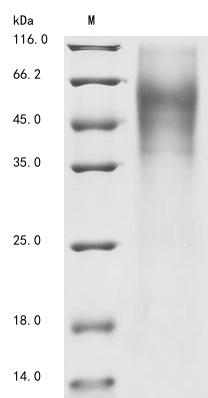Recombinant Vaccinia virus Protein B5 (PS/HR) gets expressed in yeast and comes with an N-terminal 6xHis-tag, which makes purification and detection much easier. The protein includes amino acids 18-279, creating what appears to be a partial but still functional form. SDS-PAGE analysis shows purity levels above 85%, and this product is intended for research applications where reliable performance matters.
Protein B5 acts as a structural piece of the Vaccinia virus. It plays what seems to be a crucial role in how the virus assembles and exits cells. The protein is involved in forming the viral envelope - something that's essential for releasing mature virions. Getting a better handle on how Protein B5 functions and interacts may provide useful insights into viral life cycles and could help in developing antiviral strategies.
Potential Applications
Note: The applications listed below are based on what we know about this protein's biological functions, published research, and experience from experts in the field. However, we haven't fully tested all of these applications ourselves yet. We'd recommend running some preliminary tests first to make sure they work for your specific research goals.
Vaccinia virus Protein B5 (PS/HR) is a viral envelope protein that requires proper folding, disulfide bond formation, and specific post-translational modifications for its functional role in viral entry and egress. The yeast expression system provides a eukaryotic environment that supports better folding than bacterial systems, but may not fully replicate the complex folding requirements of this viral protein. The partial fragment (18-279aa) represents only a portion of the full-length protein and may lack a complete structural context. While yeast expression increases the probability of correct folding compared to prokaryotic systems, experimental validation remains essential to confirm functional status.
1. Antibody Development and Validation Studies
Antibody development primarily relies on antigenic sequence recognition. If correctly folded (verified), the protein is excellent for generating conformation-sensitive antibodies that recognize native B5 epitopes. If misfolded/unverified, it remains suitable for producing antibodies against linear epitopes, though these may not efficiently detect the native protein structure in viral contexts.
2. Protein-Protein Interaction Studies
This application carries a significant risk without folding validation. Protein-protein interactions require precise tertiary structure. If correctly folded (verified), the fragment might identify domain-specific interaction partners involved in viral pathogenesis. If misfolded/unverified, the risk of non-specific binding or interaction failure makes results biologically unreliable.
3. ELISA-Based Binding Assays
ELISA applications depend on antibody-epitope recognition rather than functional conformation. If correctly folded (verified), the protein serves as an excellent standard for detecting native B5 antibodies. If misfolded/unverified, it remains suitable as an immunoassay standard for detecting immunoreactive material.
4. Biochemical Characterization Studies
These studies are essential for determining protein quality regardless of folding state. If correctly folded (verified), characterization provides insights into the protein's biophysical properties. If misfolded/unverified, analysis yields valuable physical property data for this specific preparation.
Final Recommendation & Action Plan
The yeast expression system provides better eukaryotic folding conditions than bacterial systems, but experimental validation is crucial before functional applications for this viral protein. Begin with Application 4 (Biochemical Characterization) to assess folding quality through size-exclusion chromatography, circular dichroism spectroscopy, and disulfide bond analysis. If correct folding is verified, proceed cautiously with Applications 1 (conformational antibodies) and 2 for antibody development and interaction studies. Application 3 (ELISA Standard) can proceed immediately regardless of folding status. If misfolding is detected, limit applications to linear epitope antibody production (Application 1) and basic biophysical characterization, avoiding all functional interaction studies. For reliable vaccinia virus research, consider using full-length protein from mammalian expression systems for complete functional characterization.






